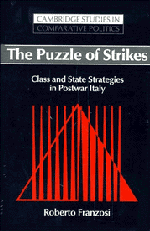Book contents
- Frontmatter
- Contents
- List of tables, figures, and equations
- Dedication
- Preface
- Acknowledgments
- 1 The puzzle box
- 2 Labor-market conditions and bargaining power
- 3 When do workers strike? How the economy matters
- 4 Organizational resources and collective action
- 5 The structure of collective bargaining
- 6 Class power, politics, and conflict
- 7 Mobilization processes: the 1969 autunno caldo
- 8 Countermobilization processes: reactions by the state and employers to strike waves
- 9 The picture in the puzzle
- Epilogue
- Appendix: the data
- Notes
- Bibliography
- Index
8 - Countermobilization processes: reactions by the state and employers to strike waves
Published online by Cambridge University Press: 08 January 2010
- Frontmatter
- Contents
- List of tables, figures, and equations
- Dedication
- Preface
- Acknowledgments
- 1 The puzzle box
- 2 Labor-market conditions and bargaining power
- 3 When do workers strike? How the economy matters
- 4 Organizational resources and collective action
- 5 The structure of collective bargaining
- 6 Class power, politics, and conflict
- 7 Mobilization processes: the 1969 autunno caldo
- 8 Countermobilization processes: reactions by the state and employers to strike waves
- 9 The picture in the puzzle
- Epilogue
- Appendix: the data
- Notes
- Bibliography
- Index
Summary
The action effects of the mobilization drive of one unit depend considerably on the degree to which this drive triggers counter-mobilizations in other units in the same system or situation, which seek to neutralize the new power of the mobilizing unit or to block its intended self-changes … this is the case with mobilization; the mobilization of a unit frequently does trigger the mobilization of opponents.
Etzioni (1968, pp. 412–13)The great wave-year mobilizations … were invariably rewarded with some kind of legislative success, the ultimate touchstone of the value of political action.
Shorter and Tilly (1974, p. 145)It would be tedious in the extreme to take the reader along every inch of the road travelled by the main currents of the fear … It is however possible to convey in reasonably clear terms how these currents moved across the country.
Lefebvre (1973,p. 171)SWITCHING SIDES: THE VIEW FROM ABOVE
Mobilization of a group is likely to lead to countermobilizations by other groups. In the case of industrial conflict both political and economic elites may respond. And if the telltale signs of the magnitude of a mobilization process are the speed and extent of the elites' responses, then the 1968–72 strike wave was a momentous process. Political elites reacted quickly, in some cases repressing but mostly facilitating those official, large-scale organizations (i.e., unions) that could control conflict. In the case of industrial conflict, political elites could also remain aloof from the movement, letting social classes deal with their problems on their own. Prime Minister Giolitti adopted such a hands-off strategy during the 1919-20 “red years” (biennio rosso).
- Type
- Chapter
- Information
- The Puzzle of StrikesClass and State Strategies in Postwar Italy, pp. 301 - 342Publisher: Cambridge University PressPrint publication year: 1995

